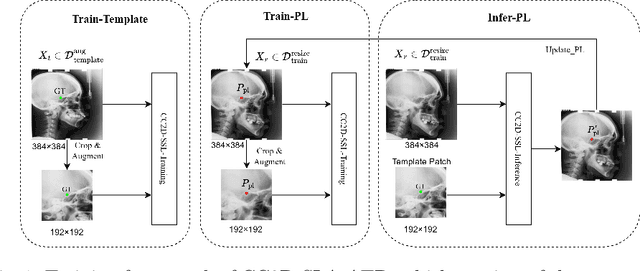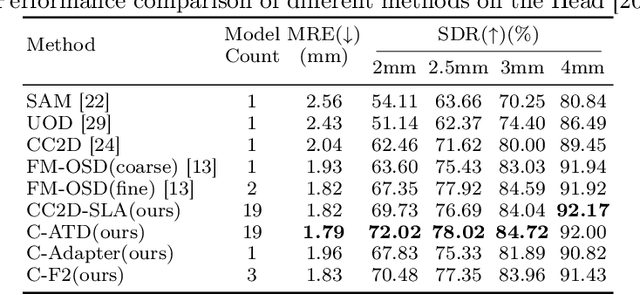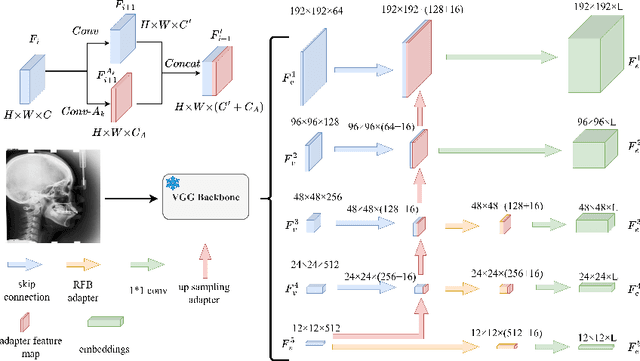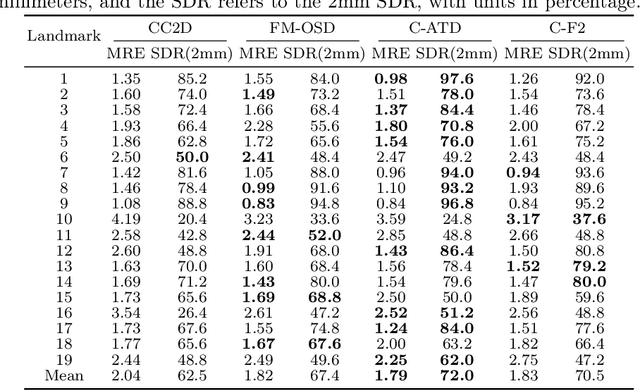Xu He
and Other Contributors
From Inpainting to Editing: A Self-Bootstrapping Framework for Context-Rich Visual Dubbing
Dec 31, 2025Abstract:Audio-driven visual dubbing aims to synchronize a video's lip movements with new speech, but is fundamentally challenged by the lack of ideal training data: paired videos where only a subject's lip movements differ while all other visual conditions are identical. Existing methods circumvent this with a mask-based inpainting paradigm, where an incomplete visual conditioning forces models to simultaneously hallucinate missing content and sync lips, leading to visual artifacts, identity drift, and poor synchronization. In this work, we propose a novel self-bootstrapping framework that reframes visual dubbing from an ill-posed inpainting task into a well-conditioned video-to-video editing problem. Our approach employs a Diffusion Transformer, first as a data generator, to synthesize ideal training data: a lip-altered companion video for each real sample, forming visually aligned video pairs. A DiT-based audio-driven editor is then trained on these pairs end-to-end, leveraging the complete and aligned input video frames to focus solely on precise, audio-driven lip modifications. This complete, frame-aligned input conditioning forms a rich visual context for the editor, providing it with complete identity cues, scene interactions, and continuous spatiotemporal dynamics. Leveraging this rich context fundamentally enables our method to achieve highly accurate lip sync, faithful identity preservation, and exceptional robustness against challenging in-the-wild scenarios. We further introduce a timestep-adaptive multi-phase learning strategy as a necessary component to disentangle conflicting editing objectives across diffusion timesteps, thereby facilitating stable training and yielding enhanced lip synchronization and visual fidelity. Additionally, we propose ContextDubBench, a comprehensive benchmark dataset for robust evaluation in diverse and challenging practical application scenarios.
Exploring the Potential of Spiking Neural Networks in UWB Channel Estimation
Dec 30, 2025Abstract:Although existing deep learning-based Ultra-Wide Band (UWB) channel estimation methods achieve high accuracy, their computational intensity clashes sharply with the resource constraints of low-cost edge devices. Motivated by this, this letter explores the potential of Spiking Neural Networks (SNNs) for this task and develops a fully unsupervised SNN solution. To enable a comprehensive performance analysis, we devise an extensive set of comparative strategies and evaluate them on a compelling public benchmark. Experimental results show that our unsupervised approach still attains 80% test accuracy, on par with several supervised deep learning-based strategies. Moreover, compared with complex deep learning methods, our SNN implementation is inherently suited to neuromorphic deployment and offers a drastic reduction in model complexity, bringing significant advantages for future neuromorphic practice.
UnityVideo: Unified Multi-Modal Multi-Task Learning for Enhancing World-Aware Video Generation
Dec 08, 2025Abstract:Recent video generation models demonstrate impressive synthesis capabilities but remain limited by single-modality conditioning, constraining their holistic world understanding. This stems from insufficient cross-modal interaction and limited modal diversity for comprehensive world knowledge representation. To address these limitations, we introduce UnityVideo, a unified framework for world-aware video generation that jointly learns across multiple modalities (segmentation masks, human skeletons, DensePose, optical flow, and depth maps) and training paradigms. Our approach features two core components: (1) dynamic noising to unify heterogeneous training paradigms, and (2) a modality switcher with an in-context learner that enables unified processing via modular parameters and contextual learning. We contribute a large-scale unified dataset with 1.3M samples. Through joint optimization, UnityVideo accelerates convergence and significantly enhances zero-shot generalization to unseen data. We demonstrate that UnityVideo achieves superior video quality, consistency, and improved alignment with physical world constraints. Code and data can be found at: https://github.com/dvlab-research/UnityVideo
A Content-Preserving Secure Linguistic Steganography
Nov 16, 2025



Abstract:Existing linguistic steganography methods primarily rely on content transformations to conceal secret messages. However, they often cause subtle yet looking-innocent deviations between normal and stego texts, posing potential security risks in real-world applications. To address this challenge, we propose a content-preserving linguistic steganography paradigm for perfectly secure covert communication without modifying the cover text. Based on this paradigm, we introduce CLstega (\textit{C}ontent-preserving \textit{L}inguistic \textit{stega}nography), a novel method that embeds secret messages through controllable distribution transformation. CLstega first applies an augmented masking strategy to locate and mask embedding positions, where MLM(masked language model)-predicted probability distributions are easily adjustable for transformation. Subsequently, a dynamic distribution steganographic coding strategy is designed to encode secret messages by deriving target distributions from the original probability distributions. To achieve this transformation, CLstega elaborately selects target words for embedding positions as labels to construct a masked sentence dataset, which is used to fine-tune the original MLM, producing a target MLM capable of directly extracting secret messages from the cover text. This approach ensures perfect security of secret messages while fully preserving the integrity of the original cover text. Experimental results show that CLstega can achieve a 100\% extraction success rate, and outperforms existing methods in security, effectively balancing embedding capacity and security.
HuMo: Human-Centric Video Generation via Collaborative Multi-Modal Conditioning
Sep 10, 2025Abstract:Human-Centric Video Generation (HCVG) methods seek to synthesize human videos from multimodal inputs, including text, image, and audio. Existing methods struggle to effectively coordinate these heterogeneous modalities due to two challenges: the scarcity of training data with paired triplet conditions and the difficulty of collaborating the sub-tasks of subject preservation and audio-visual sync with multimodal inputs. In this work, we present HuMo, a unified HCVG framework for collaborative multimodal control. For the first challenge, we construct a high-quality dataset with diverse and paired text, reference images, and audio. For the second challenge, we propose a two-stage progressive multimodal training paradigm with task-specific strategies. For the subject preservation task, to maintain the prompt following and visual generation abilities of the foundation model, we adopt the minimal-invasive image injection strategy. For the audio-visual sync task, besides the commonly adopted audio cross-attention layer, we propose a focus-by-predicting strategy that implicitly guides the model to associate audio with facial regions. For joint learning of controllabilities across multimodal inputs, building on previously acquired capabilities, we progressively incorporate the audio-visual sync task. During inference, for flexible and fine-grained multimodal control, we design a time-adaptive Classifier-Free Guidance strategy that dynamically adjusts guidance weights across denoising steps. Extensive experimental results demonstrate that HuMo surpasses specialized state-of-the-art methods in sub-tasks, establishing a unified framework for collaborative multimodal-conditioned HCVG. Project Page: https://phantom-video.github.io/HuMo.
RationalVLA: A Rational Vision-Language-Action Model with Dual System
Jun 12, 2025Abstract:A fundamental requirement for real-world robotic deployment is the ability to understand and respond to natural language instructions. Existing language-conditioned manipulation tasks typically assume that instructions are perfectly aligned with the environment. This assumption limits robustness and generalization in realistic scenarios where instructions may be ambiguous, irrelevant, or infeasible. To address this problem, we introduce RAtional MAnipulation (RAMA), a new benchmark that challenges models with both unseen executable instructions and defective ones that should be rejected. In RAMA, we construct a dataset with over 14,000 samples, including diverse defective instructions spanning six dimensions: visual, physical, semantic, motion, safety, and out-of-context. We further propose the Rational Vision-Language-Action model (RationalVLA). It is a dual system for robotic arms that integrates the high-level vision-language model with the low-level manipulation policy by introducing learnable latent space embeddings. This design enables RationalVLA to reason over instructions, reject infeasible commands, and execute manipulation effectively. Experiments demonstrate that RationalVLA outperforms state-of-the-art baselines on RAMA by a 14.5% higher success rate and 0.94 average task length, while maintaining competitive performance on standard manipulation tasks. Real-world trials further validate its effectiveness and robustness in practical applications. Our project page is https://irpn-eai.github.io/rationalvla.
SentinelAgent: Graph-based Anomaly Detection in Multi-Agent Systems
May 30, 2025Abstract:The rise of large language model (LLM)-based multi-agent systems (MAS) introduces new security and reliability challenges. While these systems show great promise in decomposing and coordinating complex tasks, they also face multi-faceted risks across prompt manipulation, unsafe tool usage, and emergent agent miscoordination. Existing guardrail mechanisms offer only partial protection, primarily at the input-output level, and fall short in addressing systemic or multi-point failures in MAS. In this work, we present a system-level anomaly detection framework tailored for MAS, integrating structural modeling with runtime behavioral oversight. Our approach consists of two components. First, we propose a graph-based framework that models agent interactions as dynamic execution graphs, enabling semantic anomaly detection at node, edge, and path levels. Second, we introduce a pluggable SentinelAgent, an LLM-powered oversight agent that observes, analyzes, and intervenes in MAS execution based on security policies and contextual reasoning. By bridging abstract detection logic with actionable enforcement, our method detects not only single-point faults and prompt injections but also multi-agent collusion and latent exploit paths. We validate our framework through two case studies, including an email assistant and Microsoft's Magentic-One system, demonstrating its ability to detect covert risks and provide explainable root-cause attribution. Our work lays the foundation for more trustworthy, monitorable, and secure agent-based AI ecosystems.
Pangu Embedded: An Efficient Dual-system LLM Reasoner with Metacognition
May 29, 2025



Abstract:This work presents Pangu Embedded, an efficient Large Language Model (LLM) reasoner developed on Ascend Neural Processing Units (NPUs), featuring flexible fast and slow thinking capabilities. Pangu Embedded addresses the significant computational costs and inference latency challenges prevalent in existing reasoning-optimized LLMs. We propose a two-stage training framework for its construction. In Stage 1, the model is finetuned via an iterative distillation process, incorporating inter-iteration model merging to effectively aggregate complementary knowledge. This is followed by reinforcement learning on Ascend clusters, optimized by a latency-tolerant scheduler that combines stale synchronous parallelism with prioritized data queues. The RL process is guided by a Multi-source Adaptive Reward System (MARS), which generates dynamic, task-specific reward signals using deterministic metrics and lightweight LLM evaluators for mathematics, coding, and general problem-solving tasks. Stage 2 introduces a dual-system framework, endowing Pangu Embedded with a "fast" mode for routine queries and a deeper "slow" mode for complex inference. This framework offers both manual mode switching for user control and an automatic, complexity-aware mode selection mechanism that dynamically allocates computational resources to balance latency and reasoning depth. Experimental results on benchmarks including AIME 2024, GPQA, and LiveCodeBench demonstrate that Pangu Embedded with 7B parameters, outperforms similar-size models like Qwen3-8B and GLM4-9B. It delivers rapid responses and state-of-the-art reasoning quality within a single, unified model architecture, highlighting a promising direction for developing powerful yet practically deployable LLM reasoners.
Pangu Ultra MoE: How to Train Your Big MoE on Ascend NPUs
May 07, 2025



Abstract:Sparse large language models (LLMs) with Mixture of Experts (MoE) and close to a trillion parameters are dominating the realm of most capable language models. However, the massive model scale poses significant challenges for the underlying software and hardware systems. In this paper, we aim to uncover a recipe to harness such scale on Ascend NPUs. The key goals are better usage of the computing resources under the dynamic sparse model structures and materializing the expected performance gain on the actual hardware. To select model configurations suitable for Ascend NPUs without repeatedly running the expensive experiments, we leverage simulation to compare the trade-off of various model hyperparameters. This study led to Pangu Ultra MoE, a sparse LLM with 718 billion parameters, and we conducted experiments on the model to verify the simulation results. On the system side, we dig into Expert Parallelism to optimize the communication between NPU devices to reduce the synchronization overhead. We also optimize the memory efficiency within the devices to further reduce the parameter and activation management overhead. In the end, we achieve an MFU of 30.0% when training Pangu Ultra MoE, with performance comparable to that of DeepSeek R1, on 6K Ascend NPUs, and demonstrate that the Ascend system is capable of harnessing all the training stages of the state-of-the-art language models. Extensive experiments indicate that our recipe can lead to efficient training of large-scale sparse language models with MoE. We also study the behaviors of such models for future reference.
Landmarks Are Alike Yet Distinct: Harnessing Similarity and Individuality for One-Shot Medical Landmark Detection
Mar 20, 2025



Abstract:Landmark detection plays a crucial role in medical imaging applications such as disease diagnosis, bone age estimation, and therapy planning. However, training models for detecting multiple landmarks simultaneously often encounters the "seesaw phenomenon", where improvements in detecting certain landmarks lead to declines in detecting others. Yet, training a separate model for each landmark increases memory usage and computational overhead. To address these challenges, we propose a novel approach based on the belief that "landmarks are distinct" by training models with pseudo-labels and template data updated continuously during the training process, where each model is dedicated to detecting a single landmark to achieve high accuracy. Furthermore, grounded on the belief that "landmarks are also alike", we introduce an adapter-based fusion model, combining shared weights with landmark-specific weights, to efficiently share model parameters while allowing flexible adaptation to individual landmarks. This approach not only significantly reduces memory and computational resource requirements but also effectively mitigates the seesaw phenomenon in multi-landmark training. Experimental results on publicly available medical image datasets demonstrate that the single-landmark models significantly outperform traditional multi-point joint training models in detecting individual landmarks. Although our adapter-based fusion model shows slightly lower performance compared to the combined results of all single-landmark models, it still surpasses the current state-of-the-art methods while achieving a notable improvement in resource efficiency.
 Add to Chrome
Add to Chrome Add to Firefox
Add to Firefox Add to Edge
Add to Edge